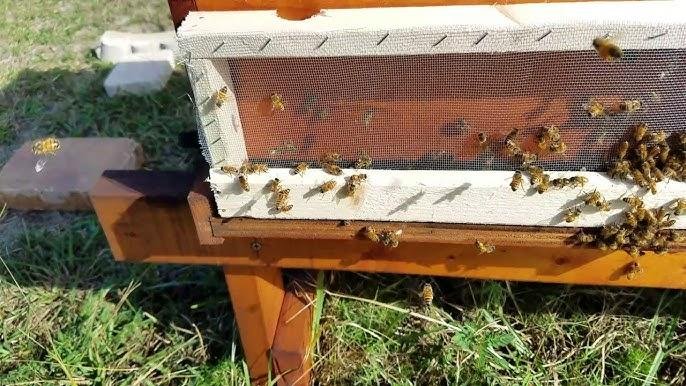As a beekeeper, protecting your hive from external threats is essential. While bee colonies generally thrive in harmony, certain times of the year bring risks that can disrupt their balance, one of the most significant being “robbing.” During these periods, stronger hives may invade weaker ones, stealing honey and even threatening the survival of the colony. A beehive robbing screen can be a vital piece of equipment for beekeepers aiming to prevent such attacks. In this article, we’ll explore why every beekeeper needs a beehive robbing screen, the benefits it provides, and how to install and use one effectively.
To handle these tasks safely, wearing high-quality beekeeping suits and beekeeping gloves is crucial. A reliable beekeeping suit offers protection against stings, allowing you to inspect your hive confidently without causing harm to yourself or your bees. Beekeeping suits should be durable, breathable, and provide full-body coverage, while beekeeping gloves should offer dexterity and protection, enabling you to handle hive components, install robbing screens, and care for your bees without fear of stings.
Equipped with a beehive robbing screen, the best beekeeping suit, and protective gloves, beekeepers are well-prepared to defend their hives and keep their colonies healthy and secure.
What Is a Beehive Robbing Screen?
A beehive robbing screen is a simple yet effective tool designed to prevent robbing, where bees from one hive raid another for honey. Robbing screens cover the hive entrance, allowing resident bees to navigate around the screen and access the hive while confusing intruders. This confusion keeps robber bees from entering the hive, ensuring that the colony’s resources remain secure.
Using a robbing prevention tool like a robbing screen can greatly reduce the risks of robbing, especially during seasonal changes when resources like nectar are scarce, and bees may be more inclined to steal from other colonies.
Signs of Robbing in Your Beehive
How do you know if your hive is under attack? Detecting the signs of bee robbing early is essential to prevent harm to your colony. Here are a few indicators to watch for:
- Increased Aggression: Bees become highly agitated, and you may notice more fights near the hive entrance.
- Dead Bees Around the Entrance: When robber bees try to invade, guard bees will often kill them, resulting in a higher number of dead bees near the hive entrance.
- Chaotic Flight Patterns: Instead of a steady flow of bees coming and going, robbing bees dart around quickly, searching for entry points.
- Depleted Honey Stores: If you notice a rapid decrease in honey supply without signs of natural consumption, robbing could be the cause.
By being vigilant about these hive robbing indicators, beekeepers can take immediate action to protect their bees.
How a Robbing Screen Helps Prevent Robbing
Installing a beehive robbing screen is one of the most effective robbing prevention strategies. Here’s how it works:
- Limited Entry Points: Robbing screens restrict access to the hive entrance, often requiring bees to find alternate routes or go through small gaps that only resident bees understand.
- Behavioral Barrier: The unique design confuses intruder bees while familiar bees, who are accustomed to the layout, can bypass the screen easily. Intruders become disoriented, giving up their attempts to rob the hive.
- Strengthening the Hive’s Defense: With the screen in place, guard bees have an added advantage, using their energy to defend fewer entry points, which bolsters hive security during vulnerable periods.
By utilizing this beekeeping security tool, beekeepers can reduce the chances of robbing, ensuring that their colonies remain strong and productive.
Types of Beehive Robbing Screens
When it comes to robbing screens, there are several types, each catering to different setups and beekeeper preferences. Choosing the right one for your hive setup can maximize protection.
- Standard Robbing Screens: These screens cover the entire hive entrance and usually come with adjustable openings.
- Ventilated Robbing Screens: In warmer climates, ventilated screens allow airflow while still deterring robber bees.
- Entrance Reducers with Robbing Screen Features: These combine an entrance reducer with a robbing screen, providing both temperature control and added security.
Knowing the different robbing screen types helps beekeepers pick the best fit for their needs and location, providing both protection and comfort for their colonies.
Installing and Using a Robbing Screen Effectively
Setting up a robbing screen might seem daunting initially, but it’s quite simple with the right instructions. Follow these steps to install a robbing screen and protect your hive from robber bees effectively:
- Choose the Right Location: Position the robbing screen over the hive entrance, ensuring that it fully covers the entry point.
- Secure the Screen: Attach the screen firmly using clips or other fasteners to prevent any gaps that robber bees could exploit.
- Guide Your Resident Bees: Resident bees may need a few days to become accustomed to the screen, but they’ll quickly learn the alternate entry paths.
- Monitor Hive Activity: Keep an eye on the hive to ensure that the resident bees can enter and exit smoothly while intruders are effectively blocked.
Using a robbing screen effectively depends on proper hive setup and regular monitoring, especially during periods when robbing behavior is most common.
Additional Tips to Prevent Robbing in Beehives
While robbing screens provide a strong defense, combining them with other hive protection tips can further protect your colonies. Here are additional methods to prevent robbing:
- Limit Hive Disturbances: Avoid frequent inspections during robbing season, as this can attract robbers.
- Feed Bees Internally: If feeding is necessary, opt for internal feeders rather than open feeding, which can attract nearby colonies.
- Reduce Hive Entrances: During peak robbing seasons, using smaller entrances reduces vulnerability by giving guard bees fewer areas to defend.
- Maintain Strong Colonies: Weak colonies are more susceptible to robbing. Keep colonies healthy, with ample resources, to reduce their risk of becoming a target.
Combining these preventive measures with the protection of a robbing screen ensures that your hive is well-guarded against robbing attempts, helping your bees focus on their work without unnecessary stress.
Conclusion
Every beekeeper should consider using a beehive robbing screen to safeguard their colonies from potential robbing attacks. By investing in this simple, effective tool, beekeepers can shield their hives, ensuring their bees can work in peace and retain valuable honey stores. Alongside a robbing screen, using additional beekeeper essentials and preventive strategies can further enhance hive protection, especially during vulnerable periods when robbing is most likely.
Incorporating a beehive robbing screen into your beekeeping routine is more than just a preventive measure; it’s a critical step in responsible beekeeping, preserving both the health and productivity of your hive.



More Stories
Best PCD Pharma Franchise Company in Kerala–Oasis Bio Bloom
Breathtaking Places to Explore in New Zealand
Experience Luxury with the Best Limousine Service in Detroit